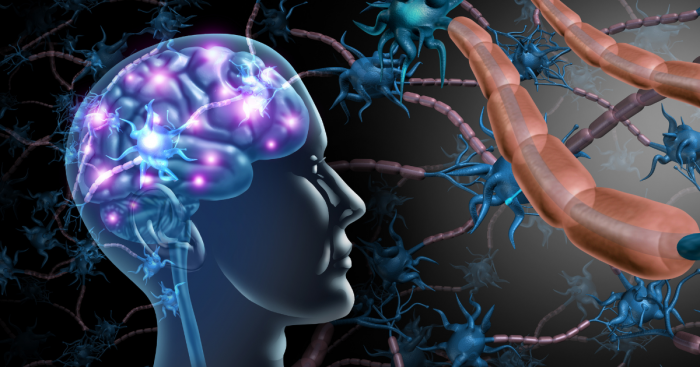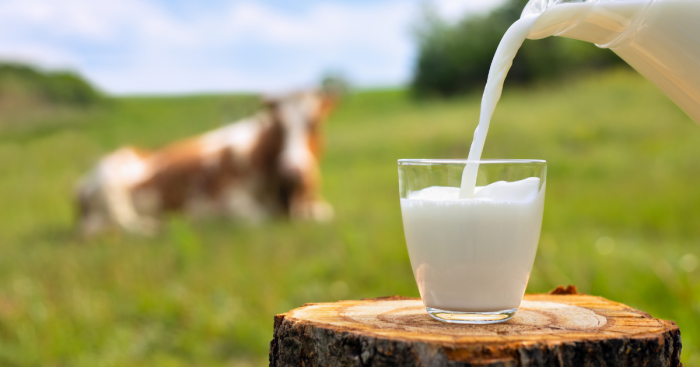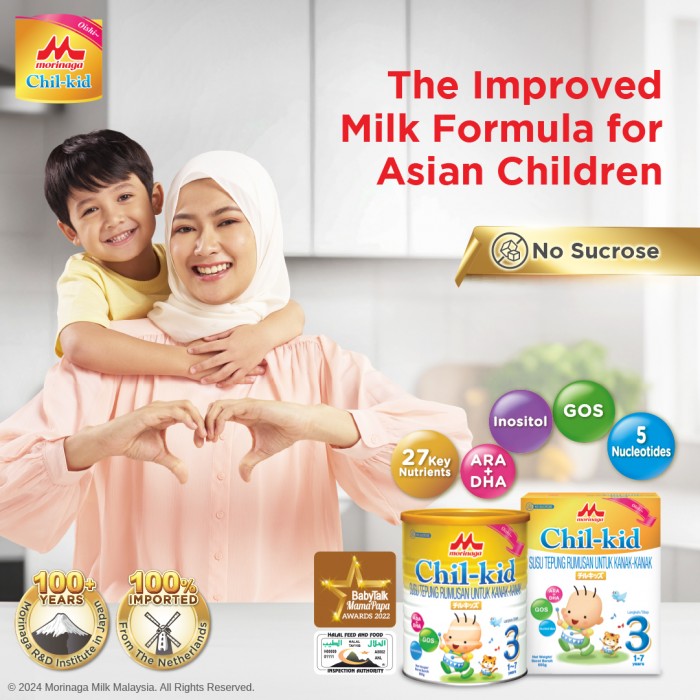If you look at the ingredients list of the new and improved Morinaga Chil-kid, you would notice that there is the addition of a new nutrient called Inositol.
What is Inositol and why is it in the formula milk?
What is Inositol and What is its Function?
Inositol[1], also known as myo-Inositol, is a form of sugar[2] or a naturally-occurring carbohydrate[3] that is found in milk − both human milk and cow’s milk − and some foods such as fruits, beans, grains and nuts[4]. Inositol is crucial for many different physiological processes at the cellular level in people particularly in babies and children, where it is needed for brain development, nerve function and healthy nerve growth.
Although Inositol is a carbohydrate or a type of sugar, it is not digested like other carbohydrates or sugars to supply energy for the body. Rather, it absorbed and used as a key ingredient to form larger complex compounds such as proteins, hormones, neurotransmitters and cell membranes[5].
It also influences the hormone Insulin which controls blood sugar − which is why it is often used to treat those with Diabetes[6] − and affects the neurotransmitters or chemical messengers of the brain and nerve cells such as Serotonin and Dopamine[7] – both of which are known as the body’s “feel-good” hormones.
Serotonin is involved with emotions while Dopamine is involved in movement, coordination and feelings of pleasure. From here it can be seen that through Serotonin and Dopamine, Inositol influences coordination, behaviour, emotion and mood.
Other ways Inositol supports tissues and processes are:
- It plays a key role in forming the cell tissues of the pulmonary surfactant (the complex and surface-active material) of the lungs necessary for breathing. This is why Inositol is a crucial nutrient needed in preventing respiratory distress syndrome[8] common in premature babies. Even if the infant is not a pre-term, Inositol strengthens and matures the lungs and helps regulate the organ[9] as the child grows.
- As it is in cell membranes, it helps to maintain cell structure and integrity.
- It is needed to transmit the correct signals between cells in the nervous system.
- It has antioxidant and anti-inflammatory properties[10].
- It is involved in the complex insulin signalling network which regulates glucose, lipid and energy via its action on the liver, skeletal muscles and adipose tissues. Inositol also has benefits for adults, not only for those who are insulin-resistant but also those with mental health issues such as depression, panic disorders[11], obsessive compulsive disorder (OCD)[12] and even Polycycstic Overy Syndrome (PCOS)[13], Metabolic Syndrome[14] and Bipolar Disorder[15].
- On Paediatric Bipolar Disorder, a study was held on 24 children[16] aged five to 12 years with Bipolar Spectrum Disorder. At the end of the 12-week clinical trial, it was found that those who were given both Inositol and Omega-3 fatty acids showed reduced symptoms of mania and depression.
Why is Inositol Important for Children?

As can be seen from above, Inositol is not just a nutrient for children but is an essential component for the improvement of a myriad of disorders and the smooth running of the physiological system of both children and adults.
Where it plays its biggest role in young children, however, is its function in brain development.
Although the basic structure and the neurons (brain cells) of the brain are laid down in the time before birth, it is the formation and refinement of neural networks or connections after birth, that shape how the brain develops and functions as the child grows up.
It is these connections (also called synapses) that enable us to move, see, think, feel, communicate and do everything.
From birth to age five, the brain grows more than at any other time in life. It doubles its size in the child’s first year and then continues to grow to about 80% of its adult size by age three and 90% by age five[17]. Inositol is essential in this period of rapid growth as it paves the way for the brain and the nervous system to make their connections.
The brain itself is teeming with inositol. It is found in abundance on the glial cells[18] – the supporter and helper of nerve cells – and is involved in the formation and maintenance of myelin[19] – the fatty insulator surrounding the nerve cells. This insulation is crucial for efficient nerve signal transmission that allows the different areas of the brain to communicate with all parts of the body effectively.
Inositol and Brain Connections

Thomas Biederer, the lead researcher in a 2023 study titled “The human milk component myo-Inositol promotes neuronal connectivity”[20], says that Inositol is not only necessary for the forming of connections between brain cells but that it increased the number of synapses in the brain cells by 29%, and the size of the synapses by about 50% in the study.
What’s more, Biederer noted that the more Inositol they added, the more the synapses increased.
“The conclusion is really robust across all models that myo-Inositol promotes how nerve cells can form connections between each other,” he was reported to say[21], adding that the effects were really apparent, “when we treated the cultured neurons with myo-Inositol they looked healthier than anything we had seen before.”
Inositol is Naturally Present in Milk

Inositol is naturally occurring in breast milk as well as in cow’s milk. The levels of Inositol in breast milk are the highest in the first two weeks after birth, and after that it dwindles a little as the body, including babies, is able to make Inositol from glucose.
However, as can be seen in the above Thomas Biederer study, the higher the levels of Inositol in the brain, the healthier the synapses became.
Continued consumption of Inositol in formula milk has its benefits.
- It supports many physiological processes that are essential for a child’s optimal health, growth and development − not just for the brain – but other areas as well, including the child’s developing respiratory system. Many studies[22] have shown the beneficial effects of Inositol on aiding the proper function and appropriate development and maturation of the respiratory system.
- Children fed on formula milk that has added Inositol obtains Inositol from the cow’s milk as well as from the added Inositol to receive additional benefits.
- Because of its influence on Dopamine and Serotonin and other brain chemicals and hormones, Inositol regulates cognition, behaviour and mood.
- Inositol is associated with neurodevelopment, brain function and higher language scores in a study titled “Brain metabolite differences in one-year-old infants born small at term and association with neurodevelopmental outcome[23]”. Seventy one-year old small-born and appropriate for gestational age sized children were assessed via Magnetic Resonance Spectroscopy (MRS) and given the third edition Bayley Scales of Infant and Toddler Development (BSID-III) test. The purpose was to determine if Inositol was associated with neurodevelopment in areas such as language, motor, social-emotional and adaptive behaviour skills. Results that were evaluated a year later when the children were two years old showed there was positive correlation between Inositol and neurodevelopment. Those who obtained low scores on the BSID III language scales were found to have significantly lower Inositol levels in their brain. It was concluded that Inositol is essential for neuronal activity and that its depletion is associated with impaired in brain function.

And now Inositol is in the new and improved Morinaga Chil-kid. Alongside 45 other essential nutrients such as ARA and DHA, GOS, 5 Nucleotides, Omega 3&6 LCPs and 27 vitamins and minerals, give your child the head start she or he needs for their optimal growth and development.




